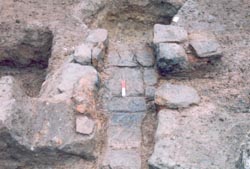
The historic environment of Cumbria is one of the county's greatest assets. It includes a varied and beautiful landscape rich with a variety of monuments and diverse archaeology. The present landscape has been modified by man for over 10,000 years, helping to create the environment in which we live and work today. Contained within it are the physical remains of our history, which form an irreplaceable resource for discovering the often hidden story of how in the past men and women lived, worked died and even thought.
There are many pressures on the historic environment, both in towns and in the countryside. Archaeological remains are vulnerable to destruction from programmes of urban and rural development, agricultural practices, forestry, mineral extraction and infrastructure projects. Similarly, the historic aspects of buildings can be irrevocably lost through redesign, adaption and demolition. The historic character of an area can be irreversibly altered by changes to the present environment. Consequently, advice is given to local authorities, land owners and managers and developers to help limit and manage the adverse impacts of change. The conservation of archaeological remains, historic buildings and historic landscape must be balanced by the need for economic growth, development and regeneration.
The Planning Process
Much of the balance needed in managing change in the historic environment is provided through the planning process. Most developments do not have a significant impact on the historic environment, but when they do the Historic Environment Service responds to consultations by local planning authorities and developers in a number of ways. Developers are advised to provide sufficient information on the historic environment aspects of their proposals to allow a decision to be made on a planning application. A brief to enable the developer to commission an archaeological consultant to collate such information will be provided free of charge.
Historic environment conditions on planning consents
In a very few cases, planning authorities may be advised that a planning application is refused in order to protect archaeological remains or historic buildings. More common is a request for a planning authority to impose a condition on any permission granted. Conditions might seek to ensure that part of a site is excluded from development, or that a development is designed to secure the survival of archaeological remains or historic elements. Sometimes where preservation of remains or historic features cannot be accomplished within a development an archaeological evaluation, landscape or building survey may be requested in advance of any development, or archaeological recording may be requested during the course of the development programme. A brief to enable the developer to commission such work will be provided free of charge.
For further information about the historic environment and development control or on historic environment conditions forming part of a planning consent contact:
Jeremy Parsons
County Offices
Kendal
Cumbria
LA9 4RQ